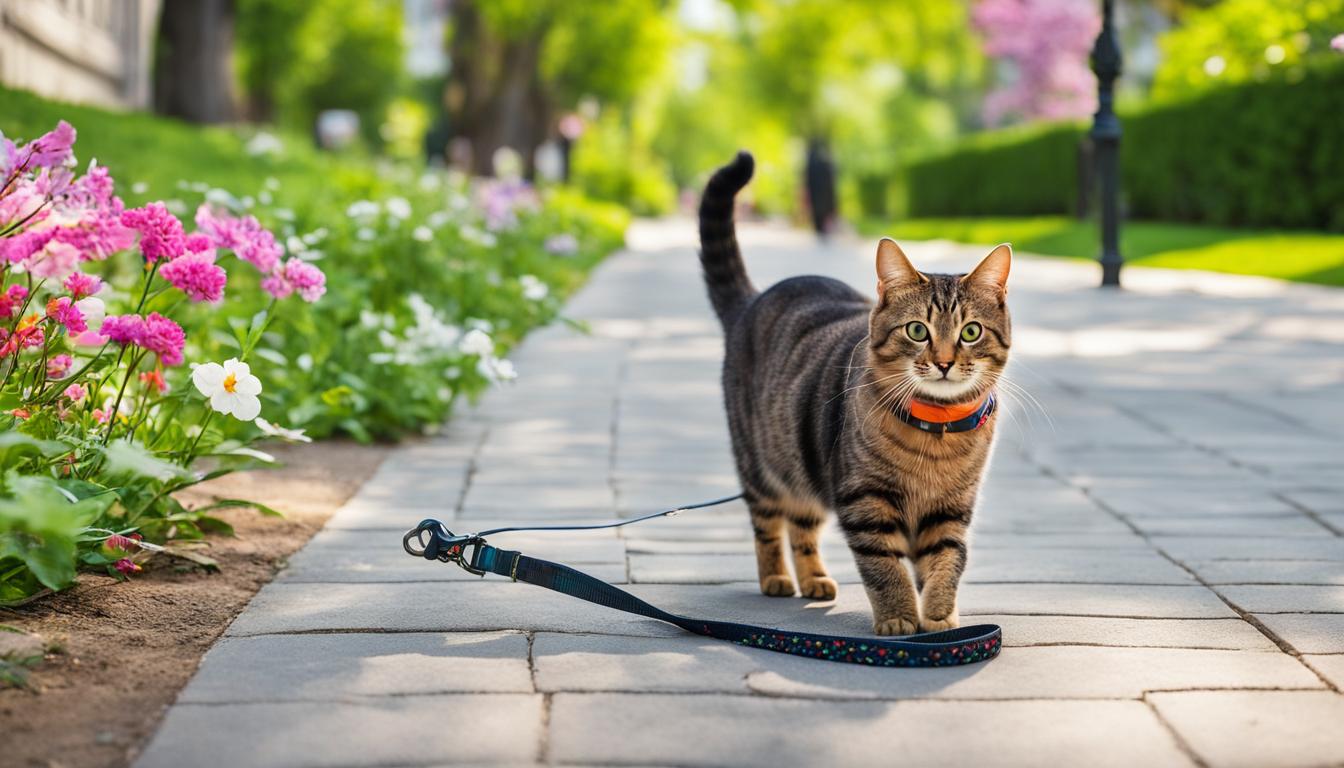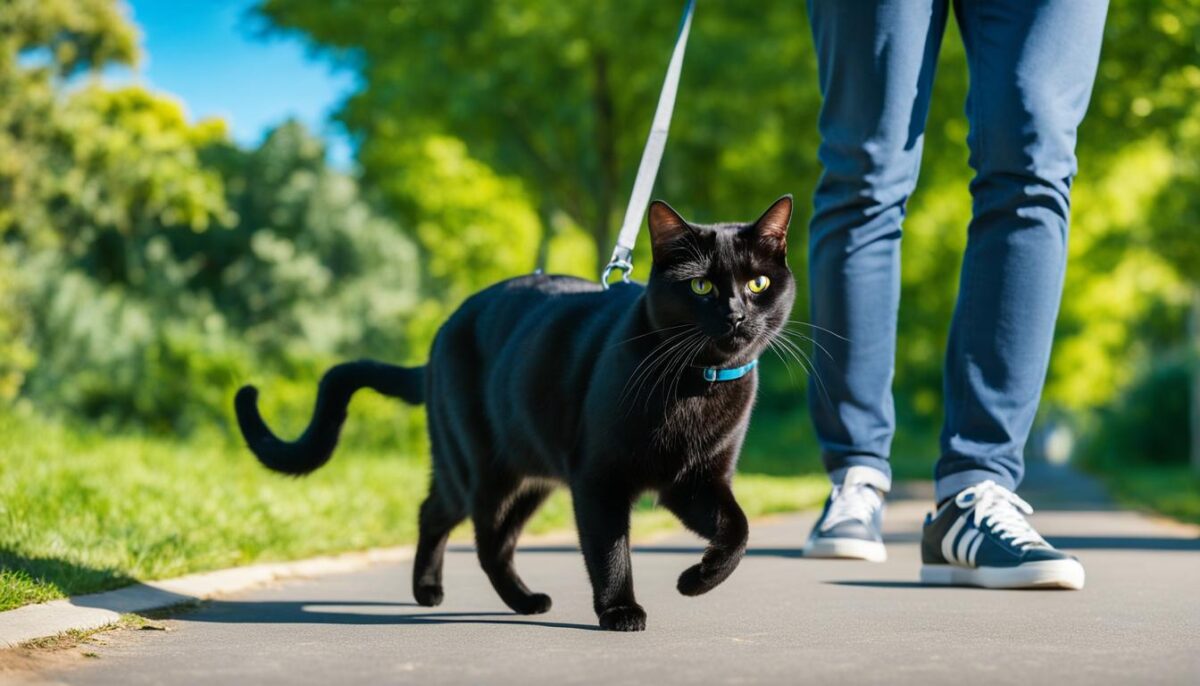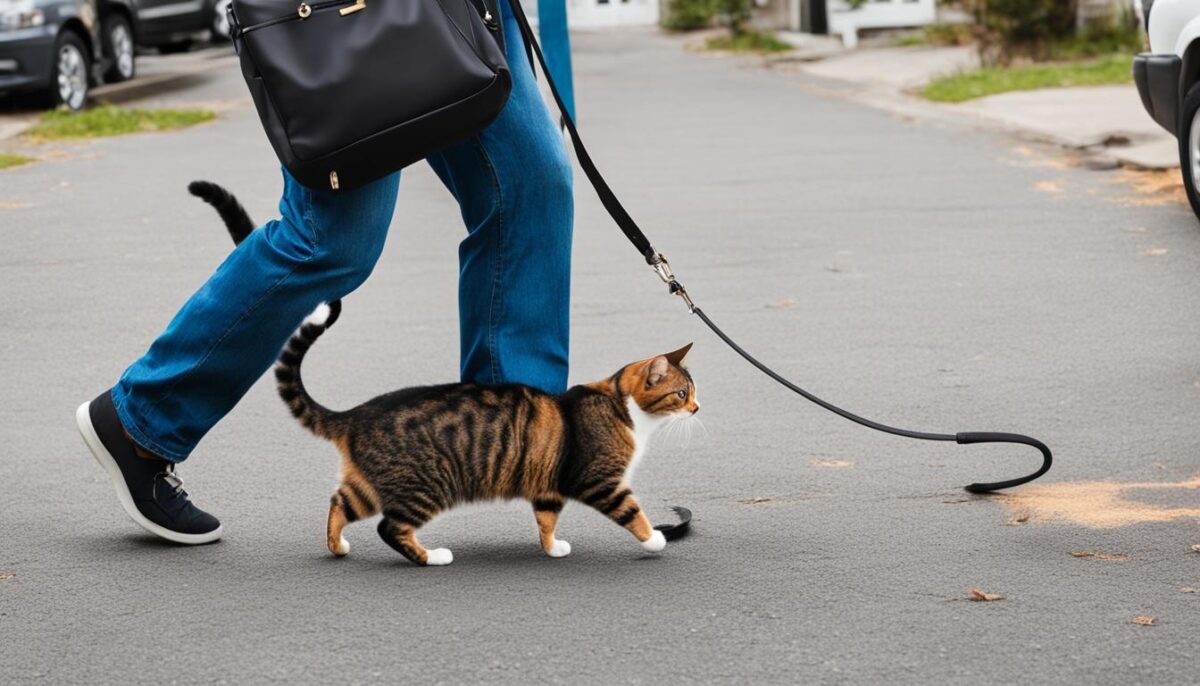Have you ever thought about taking your cat outside for some leash training for cats? It’s a fun way to have outdoor cat adventures together! Cats love to explore and see new things. When you walk your cat, it’s different from walking a dog. Your cat has special ways it acts and feels outside. So, you both can stay safe and have fun, learn the best tips and tricks to walk your cat on a leash.
If your cat seems scared when you try to walk them, do not worry. You can carry a safe space for them, like a carrier. So they can hide if they feel a need. Walking your cat can be more about stopping and sniffing around than moving fast. That’s okay! Let them take their time and enjoy the smells and sights. Your cat can have fun on a leash with your help, and you two can enjoy being outside together.
Key Takeaways
- Walking a cat on a leash is different from walking a dog.
- Use a cat harness, not a neck collar, for safety.
- Train your cat on a leash inside first before going outside.
- Keep a carrier close by in case your cat gets scared.
- Having patience is key for a fun outdoor experience with your cat.
Understanding Your Cat’s Outdoor Instincts
Have you ever watched your kitty at home and wondered why they get jumpy at the sight of birds outside the window? It’s all part of your cat’s instincts that are just like their wild cousins. When cats go outdoors, these instincts really kick in. Learning about these can make outdoor trips safer and more fun for both of you!
Cats’ Natural Predatory Behaviors
If you see your cat pounce on a toy, that’s their predatory behavior showing. Outside, this can mean they might try to chase small animals like squirrels or birds. To keep your cat safe, it’s important to keep them close on their leash and away from places where wild animals might be.
Why Cats Need Different Approaches Than Dogs
Cats are not small dogs. They see and react to the world around them in their own cat way! This means your furry friend needs special care on walks. For example, a dog might like meeting new people and dogs, but many cats do not. They can get scared and try to run away. When walking your cat, knowing cat versus dog behavior can help you keep them calm and happy.
Reacting to Potential Outdoor Threats
While a dog may bark at danger, a cat might freeze or try to hide. Outdoor safety for your cat means keeping an eye out for potential threats, like big dogs or loud noises. Staying close to home can help, and always pick them up if they look scared. Remember, understanding your cat’s outdoor instincts can make your adventures together much safer and more enjoyable.
Choosing the Right Harness for Your Cat’s Safety
When you want to walk your cat, it’s like picking out a superhero suit! You need something that fits just right and keeps your cat safe. Imagine a superhero who could wiggle out of their suit… that’s a big no-no! So when you choose a cat harness, think about getting a secure cat leash and some pet safety gear that won’t let you down.
A good harness is kind of like a comfy little jacket. It shouldn’t be too tight, or it might make your cat grumpy. You also don’t want it too loose, or your cat could slip out. A nice rule is to make sure you can slip two fingers under the harness once it’s on. That way, you know it’s not too snug or too floppy.
| Type of Cat Harness | Good Fit Guide | Safety Features |
|---|---|---|
| Vest Harness | Snug enough for two fingers under | Covers more body for better control |
| H-Harness | Adjustable straps for a custom fit | Secure buckle for extra wiggle room |
| Step-In Harness | Easy to put on for feisty felines | Padded edges to keep your kit comfy |
Remember, walking your kitty should be fun, like a stroll through a cartoon wonderland! Make sure your cat’s superhero suit—their harness—is just right. Then both of you can enjoy exploring the great outdoors, with lots of new things to sniff and sights to see!
Step-by-Step Guide to Leash Training Your Cat
If you want your cat to join you for outdoor adventures, it’s important to start with some simple steps at home. Cat leash training can be a lot of fun and helps keep your kitty safe. Let’s begin with getting them comfy in their new gear.
Introductory Phase: Getting Your Cat Used to the Harness
The first big step in cat leash training is for your cat to make friends with their harness. Start by showing the harness to your furry friend inside where they are cozy and happy. Have some yummy treats ready to give them snacks while they sniff and see the harness. It’s like saying, “Look, this new thing is pretty cool and comes with treats!”
Indoor Leash Training Techniques
After your cat seems okay with the harness, gently put it on them and let them walk around the house. It’s normal for them to act a bit funny at first—they might roll around or try to get it off. But soon, they’ll forget about it and just do their usual cat things. Now, attach the leash but let it drag behind without holding it. This is part of indoor practice and lets your cat learn there’s nothing scary about the leash. Pick it up after a while and follow your cat, giving them gentle guidance.
Transitioning from Indoor to Outdoor
Ready to explore outside? Choose a day when it’s nice and calm outdoors. No big winds or loud noises. This will make the transition to outdoors smoother. Just open the door and let your curious pal peek out. Stay close to home, like in the yard or garden, and let your cat sniff around. Have some treats in your pocket, and use your happiest voice to tell them they’re doing great!
Remember, walking your kitty on a leash isn’t a race—it’s about having happy times outside. With patience and yummy treats, your cat will start to love their walks with you!
Walking a Cat on a Leash: The Do’s and Don’ts
When you walk your kitty, keeping some important tips in mind can make the stroll nice for both of you. Cat walking tips tell us to pick a good leash. Avoid the long, roll-up leashes because if your cat runs fast, this type of leash could hurt them. It’s better to use a shorter one that helps you keep your furry friend close. Leash-walking etiquette also includes knowing where you’re going. Stay away from places where other animals hang out. They could scare your cat. If there are too many unknown sounds or scents, your cat might not feel happy.
Keep your eyes on your cat. They might get scared or want to stop. Maybe their ears go flat, their tail goes all puffy, or they might even make funny sounds. If you see this, it’s time to go home. That way, your cat keeps trusting you and feels safe during your walks. Remember, short and sweet walks are better for starters!
Follow these pet walk best practices for a good time:
- Use a sturdy leash that’s not too long.
- Keep your cat close to you.
- Stay away from places where other animals might be.
- Watch for signs your cat might be nervous or upset.
- End the walk if your cat seems scared.
To help you remember, here’s an easy table with the do’s and don’ts:
| Do’s | Don’ts |
|---|---|
| Choose a short and strong leash | Use a long, retractable leash |
| Walk in safe, quiet areas | Go where there are lots of other animals |
| Keep your cat close | Let your cat wander too far away |
| Watch for scaredy-cat signs | Ignore your cat’s body language |
| Go home if kitty is scared | Stay out too long |
If you stick to these rules, walking your cat can be fun and safe. Always think about what’s best for your cat, and you’ll both have a good time.
Creating a Safe and Enjoyable Walk for Your Cat
Walking your cat can be lots of fun! It’s important to make sure your furry friend is happy and safe. Let’s find out how to make every stroll enjoyable.
Picking the Right Time and Place to Walk
Look for quiet times to go outside for your walks. Early mornings or later in the evening can be good. Places with few cars and noises are best. That way, your cat can explore without feeling scared. Remember, always keep your cat’s fun in mind for safe pet strolls.
Understanding Your Cat’s Body Language
Notice how your cat tells you if they’re happy or not. When they’re feeling good, they might purr or have a relaxed tail. But if they look worried, their tail might be tucked under them. By reading cat signals, you can help your cat have fun and feel safe on walks.
Use of Treats and Rewards
When your cat walks well with you, give them a treat! Yummy snacks make your cat enjoy walking with you even more. Plus, if they get worried, treats can help them feel better. Always be ready to pick up your cat if they seem to be scared.
- Choose a safe area with not too much noise.
- Let your cat walk at their own pace.
- Keep an eye on your cat’s feelings through their body language.
- Use treats to help your cat feel brave and have lots of fun.
- Stay close to your cat and be ready to calm them if they’re nervous.
Remember, your cat’s tag with your information is important. It helps people know who to call if your cat gets lost. Also, make sure your friend is healthy with shots and protection from bugs before you go on an adventure.
Handling Unforeseen Challenges and Emergency Situations
When you’re out with your cat, sometimes surprises can happen. Even if you plan well, your furry friend might act in unexpected pet behaviors. Knowing what to do is really important! If your cat feels scared, it’s smart to use a towel or put them in a carrier nearby instead of holding them. This can keep you from getting scratched or bitten.
If your cat gets loose from their harness, having a microchip and a collar with a tag can help them come back home. Make sure your contact info is on their tag. It’s also a great idea to keep their health stuff, like shots for sickness and medicines for bugs, up to date.
| Safety Measure | Why It’s Important | How It Helps |
|---|---|---|
| Carry a towel or use a carrier | Prevents bites or scratches during emergency pet handling | Offers a safe way to move a scared cat |
| Microchip and ID tag on collar | Helps find your cat if they escape | Quickly reunites you with your cat |
| Up-to-date vaccinations & preventive medicine | Keeps your cat healthy from diseases and pests | Your cat is protected during outdoor adventures |
Remember, these cat safety measures are really good to think about. They can make sure both you and your cat have fun outside and stay safe.
Effective Alternatives to Walking Your Cat on a Leash
Sometimes walking your cat on a leash isn’t the perfect fit for your furry friend. That’s okay! There are other fun ways for your cat to enjoy the outdoors safely. Let’s look at some cool options like catios and pet strollers that can offer alternative outdoor cat experiences without a leash.
Benefits of Catios and Enclosures
Safe cat enclosures, or catios, are like special playhouses for cats. They can be as simple as a screened porch or as fancy as a cat castle. Catios are great because they keep cats safe while they watch birds, sniff fresh air, and feel the sun. Cats love that, and you can relax knowing they are protected.
| Types of Catios | Features | Pros |
|---|---|---|
| Window Box Catio | Attaches to window, has shelves | Good for small spaces, lets cats get fresh air |
| Freestanding Catio | Stands in the yard, lots of room | Space for climbing and jumping, great for play |
| Balcony Catio | Encloses a balcony with nets or screens | High views, feels like the wild |
Do you like watching cats have fun? Seeing them in a catio is like watching a mini jungle adventure. Neat, right?
Exploring Cat Strollers and Backpacks
Pet strollers are another wonderful idea for alternative outdoor cat experiences. Your cat can sit safely inside and see the world roll by. It’s like a moving bed with a view! Cat backpacks work too—they’re like little space bubbles on your back, just for cats.
- Your cat is safe and cozy inside.
- You can take them to parks and on walks.
- They’ll love seeing new places with you!
So if your kitty isn’t too sure about a leash, don’t worry. With these awesome ideas, you can both have lots of fun outside in a safe way. Which one does your cat fancy?
Conclusion
If you like taking your cat for walks, you’re giving them a fun way to see and sniff the outdoors! Remember to be patient. Cats have their own pace, so take your time with leash training. Picking the right harness means your cat will be both comfy and safe. And when you head out, watch how they act. This can tell you if they are having a good time!
Not every cat likes to go on walks, and that’s okay! Some cats are happiest just watching the world from a window. The most important thing is to find fun that feels good for both of you, whether it’s a cozy corner indoors or a sunny spot in the yard. The best part of outdoor adventures is making sure you and your furry friend are having a great time together while staying safe.
With these **pet adventure tips**, you’ll be ready for many sunny days and cool walks. Keep practicing, and soon you’ll be having **successful cat walks**! And if you’re just chilling in a catio, you’re still providing your cat a **positive outdoor experience**. So, go on and enjoy the outdoors with your kitty. It’s all about fun, safety, and lots of furry love!
FAQ
How do I start leash training my cat for outdoor adventures?
Begin by letting your cat get used to the harness indoors. Introduce it slowly with treats and praise and allow your cat to wear it comfortably at home before attaching the leash and guiding them gently.
Why can’t I just use a collar instead of a harness for my cat?
A harness is much safer for cats as it distributes pressure more evenly around the body when they pull or leap. A collar can cause neck strain or injury, especially if your cat is frightened or tries to jump after prey.
What are the signs my cat is not enjoying the leash walk?
Look out for body language such as a tucked tail, flattened ears, crouching, or signs of anxiety like vocalizing or attempts to escape. These cues indicate discomfort and it’s time to take a break or head back home.
How should I react to outdoor threats when walking my cat?
Stay calm and promptly carry or guide your cat away from potential threats. Use a towel or carrier to pick them up safely if needed. It’s crucial to avoid confrontation with other animals and seek a safer area immediately.
What type of leash is best for cat walking?
A sturdy, short leash gives you more control and prevents your cat from darting off, which is safer than retractable leashes. Short leashes help manage quick movement and assure better supervision during the walk.
How can I create a safe and enjoyable walking experience for my cat?
Walk your cat during quieter times of the day, be patient, and let them explore at their pace. Use treats for positive reinforcement, and watch for signs of stress or anxiety. Ensure they are properly identified with tags and microchipping for safety.
Are there alternatives if my cat doesn’t like leash walks?
Absolutely, catios provide a safe outdoor experience within an enclosed space. Cat strollers and backpacks are also a great way to let your cat enjoy the outdoors without the need for leash training.
What should I do if my cat gets loose during a walk?
If your cat escapes their harness, having them microchipped and wearing a collar with an ID tag will help reunite you. Immediately search the vicinity and contact local shelters or animal control to report your lost pet.
What safety gear should my cat have when walking outside?
Ensure your cat is equipped with a well-fitting harness, a short leash, identification tags, and is up-to-date on vaccinations as well as flea, tick, and heartworm prevention measures before venturing outdoors.
How do I know when my cat is ready to transition from indoor to outdoor leash walking?
Your cat is ready when they move confidently with the harness and leash indoors without showing signs of stress. Start with short sessions in a safe, enclosed outdoor space and gradually increase exploration as your cat shows curiosity and confidence.


